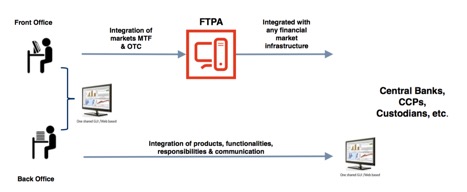The tri-party repo market was initially developed in the US in the late 70s, early 80s to drive efficiency gains in settlement and reduce operational risks. It then moved across to Europe, but in the age of fintech evolution, the choices are to either re-envision the model for a digital age, or wait while blockchain and other technology companies do it for you. A guest post from SIX.
The value of tri-party services continues to grow. Not just in repo where it was traditionally strongest, but also across securities lending, OTC derivatives and collateralized products like ABCP and special purpose vehicles. Part of this growth is due to the efficiency of the tri-party model itself while other parts are due to regulatory complexities that make tri-party a better option than managing collateral movements and valuating payment streams in-house. In 2017, repo accounted for only 61% of all tri-party assets globally, according to Finadium. Other product types made up the remaining 39%.
The existing tri-party model remains tied to a single custodian in most cases. The basic business model is built around aggregating custody assets and charging a fee. This worked well when technology limited the flexibility of market participants to move assets, but is no longer a credible argument when assets can and should be mobilized for global collateral movements. The rationale for limited connectivity across market infrastructures – including tri-party – is difficult to support.
At the same time, new technologies are producing case studies of how assets can be moved, mobilized and integrated for a broad range of market activities. Blockchain is just one example that may turn out to be a false path. Equally important are existing CSDs, CCPs and payment systems that already deliver benefits to a wide range of market participants with demonstrated security. By rethinking how business models operate and building on improved technology platforms, these infrastructure providers are well-placed to deliver outsized benefits for market participants.
The vision of SIX of a new tri-party model: Build your own!
If traditional tri-party was meant to aggregate custody assets, the vision of SIX of the next generation of tri-party flips that model entirely. SIX will launch a future tri-party agent (FTPA) model based on integration with custodial assets wherever they may reside, including other CSDs and custodians worldwide. While SIX will be the first CSD custodian in this model, we invite all other custodians and CSDs to join. A user can then access the assets across multiple custodians while not required to sign up to one tri-party service.
FTPA from SIX is a “build-your-own” model, allowing clients to network with their counterparties wherever assets currently reside. This is a relief to many market participants as FTPA creates one point of entry for all tri-party business; maintains existing custodial agreements that may have been difficult to negotiate, including pricing; and can integrate with existing technology. It is an open model rather than a captive model.
A decentralized tri-party model provides immediate cost benefits for clients as well. One point of entry to the tri-party marketplace means fewer points of connectivity that must be maintained and fewer vendors that require contract negotiation and management (see graphic). One dashboard across all tri-party agents offers a consolidated platform for reporting.

Tri-party agents have a choice in the market: Either become the sole tri-party agent globally (highly unlikely), keep trying to defend the current model with innumerable built-on features (what most are doing), or break tri-party out of the custodial box where it has lived so far (FTPA of SIX). Doing nothing is also a choice, but it is only a matter of time before a smarter fintech company is able to disintermediate the tri-party offering. The future of the tri-party model is open and decentralized.
 Giancarlo Novello is Senior Sales Manager, Securities & Exchanges, SIX. He brings an abundance of practical experience to SIX. Giancarlo is primarily responsible for facilitating institutional client growth and maintaining and expanding the SIX network of banks, insurance providers, asset managers, custodians and various third parties.
Giancarlo Novello is Senior Sales Manager, Securities & Exchanges, SIX. He brings an abundance of practical experience to SIX. Giancarlo is primarily responsible for facilitating institutional client growth and maintaining and expanding the SIX network of banks, insurance providers, asset managers, custodians and various third parties.
Giancarlo’s experience in the banking sector stretches back 30 years. After developing his expertise in the lending and borrowing segment at Credit Suisse in Zurich and Toronto, he moved on to securities lending and collateral trading at Swiss Bank Corporation Warburg and UBS Warburg. He subsequently spent six years as Head Collateral Trading at Zürcher Kantonalbank before taking on a new challenge as a Sales Trader for the corporate and markets segment at DekaBank. In 2013, he founded the e-commerce startup G.G.P.R. GmbH, where he served as a partner for two years prior to joining SIX.
Giancarlo is fluent in four languages (Italian, German, Spanish and English) and holds an Executive Program Diploma from the renowned Swiss Finance Institute.


